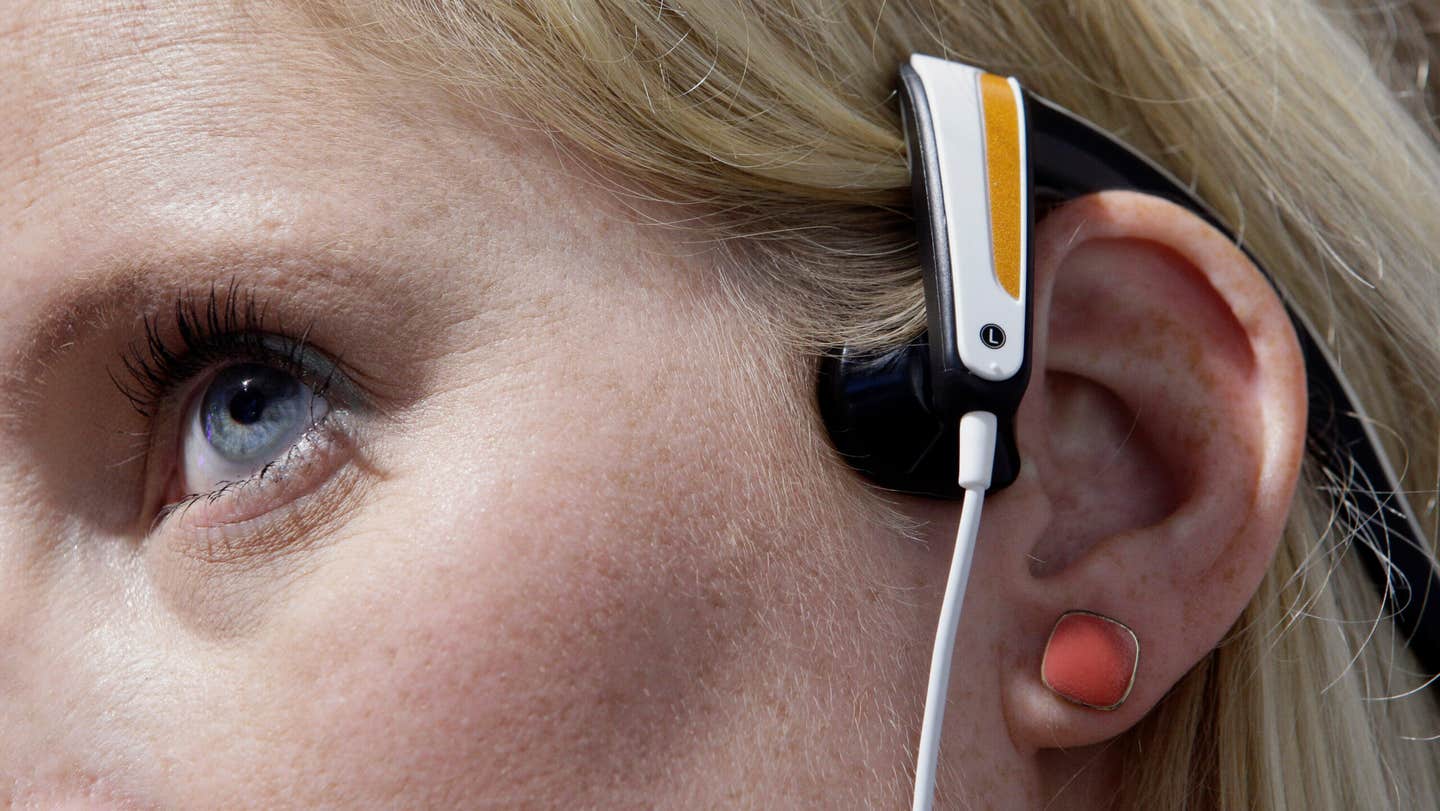Groundbreaking robotic therapy could revolutionize schizophrenia treatment
Pioneering research has uncovered the potential to induce auditory hallucinations in healthy individuals offering a glimpse into the mind.

[Dec. 18, 2023: JD Shavit, The Brighter Side of News]
Researchers have delved into the science of auditory-verbal hallucinations, shedding new light on how our brains can deceive us into hearing voices that do not exist. (CREDIT: Creative Commons)
In a groundbreaking study published in Psychological Medicine, researchers have delved into the science of auditory-verbal hallucinations, shedding new light on how our brains can deceive us into hearing voices that do not exist. This pioneering research has uncovered the potential to induce auditory hallucinations in healthy individuals using a robotically-assisted experimental procedure, offering a glimpse into the intricate workings of the human mind.
Auditory-verbal hallucinations, characterized by the perception of voices or sounds absent in reality, have long captivated the scientific community and confounded those who experience them.
Although most commonly associated with schizophrenia, these hallucinations can manifest in various psychiatric disorders and even in individuals with no known mental health issues. Previous research has pointed to disruptions in the brain's self-monitoring processes as a key factor contributing to auditory-verbal hallucinations, where the brain erroneously attributes internally generated mental events as external, leading to the perception of voices.
Pavo Orepic, a postdoctoral researcher at the University of Geneva and the study's lead author, emphasized the significance of this research, stating, "Hallucinations are complex experiences that can have a big negative impact on people who experience them. Studying hallucinations and the brain mechanisms behind them is challenging due to major methodological limitations." He further added, "This work specifically focuses on 'hearing voices,' which is the most common and highly distressing psychotic symptom."
Related Stories
The study involved 48 right-handed, French-speaking participants from the general population, all devoid of any psychiatric or neurological disorders, ensuring a diverse and healthy sample. To induce auditory hallucinations, Orepic and his team employed an innovative approach. They recorded participants' voices uttering nine one-syllable French words with negative connotations, a choice informed by previous research highlighting the prevalence of negative content in auditory hallucinations.
These recorded voices underwent processing to standardize their sound intensity and duration, ensuring uniformity across stimuli. This standardized set of recordings served as the self-voice stimuli in a voice detection task, a pivotal component of the study.
Additionally, the researchers created equivalent voice recordings from an unfamiliar person to provide both self-voice and other-voice stimuli for the study.
The research team meticulously designed a comprehensive experimental procedure to explore the induction of auditory hallucinations in healthy participants, consisting of several distinct phases:
Sensorimotor Blocks (Assessment of Illusory Effects): Participants were blindfolded and positioned between two parts of a robotic system, tasked with executing repetitive poking movements using their right index finger. These movements were replicated by the robot's rear part, creating tactile sensations on the participants' backs. Crucially, the researchers manipulated the timing of these tactile sensations, introducing a 500-millisecond delay in some cases, generating a sensory conflict. After each session of sensorimotor stimulation, participants completed a questionnaire to rate various perceptual experiences, including illusory self-touch, somatic passivity, and the presence of hallucinations.
Staircase Blocks (Defining Hearing Thresholds): This phase aimed to ascertain each participant's individual hearing threshold. A voice detection task combined with a one-up-one-down staircase procedure was employed. Participants continuously listened to bursts of pink noise and reported whether they heard a voice amidst the noise. The threshold for hearing voices was established based on participants' responses, ensuring that the voices were presented just at or near their hearing thresholds.
Task Blocks (Combining Voice Detection with Sensorimotor Stimulation): The core of the study lay in these task blocks. Participants performed the voice detection task while being exposed to sensorimotor stimulation. The critical variables included the type of sensorimotor stimulation (synchronous or asynchronous) and the type of vocal stimuli (self-voice or other-voice). Each participant underwent four task blocks, with their order carefully counterbalanced.
Task block design. The block started with 30 s of sensorimotor stimulation, which was followed by a simultaneous voice detection task. (CREDIT: Psychological Medicine)
The blocks initiated with 30 seconds of sensorimotor stimulation, followed by the voice detection task. Importantly, auditory stimuli were not synchronized with participants' movements but were presented concurrently with their robotic interactions. The primary outcome measure was the rate of vocal false alarms, representing false reports of hearing voices when no actual voices were present.
Statistical analyses unveiled the key factors influencing these false alarms. The timing of sensorimotor stimulation emerged as a pivotal factor, with synchronous touch on the back leading to a significant increase in false alarms, signifying the perception of non-existent voices. Intriguingly, these false alarms were more prevalent when participants heard their self-voices rather than other-voices, suggesting a compelling connection between sensory feedback from one's own actions and the genesis of auditory hallucinations.
Vocal false alarm rates observed in Study 1 (left) and Study 2 (right). Height of bar plots indicates the mean rate, and error bars 95% confidence intervals. (CREDIT: Psychological Medicine)
Orepic elaborated on the significance of their findings, saying, "We developed a robotic procedure able to make healthy participants hear voices when they were in fact hearing only noise. This was done by taking insights from the two most prominent theories about why voices might occur in the brain."
The research also unveiled a correlation between higher levels of delusional ideation and the experience of auditory hallucinations, reinforcing the notion that cognitive factors play a crucial role in these phenomena. Orepic noted, "We observed that people who are more prone to delusional thinking were more likely to report lab-induced voices. This supports the theory that experiences like hallucinations and delusions are present across the phenomenological spectrum even in the general population."
Increase in delusional ideation score was related to an increase in vocal false alarms rate in both studies. Shaded areas around each curve represent 95% confidence intervals. (CREDIT: Psychological Medicine)
Despite its groundbreaking nature, the study does have its limitations. It primarily focused on vocal false alarms as the primary outcome measure, leaving room for future research to explore other facets of auditory-verbal hallucinations, such as the emotional content of the voices and their perceived reality. Furthermore, the study employed a relatively small sample size drawn from the general population. Future studies could benefit from larger and more diverse samples, including individuals with diagnosed psychiatric conditions.
Orepic emphasized the need for further investigation, stating, "Our lab-induced voices are still very far from the real clinical experience of hearing voices." He continued, "Future work should try to address different phenomenological aspects of the experience."
By simulating auditory hallucinations in the laboratory, this work holds the potential for profound implications in understanding and addressing this debilitating psychotic symptom, whose etiology remains largely enigmatic.
For more science stories check out our New Discoveries section at The Brighter Side of News.
Note: Materials provided above by The Brighter Side of News. Content may be edited for style and length.
Like these kind of feel good stories? Get the Brighter Side of News' newsletter.



